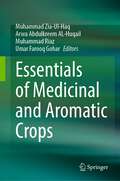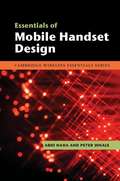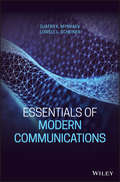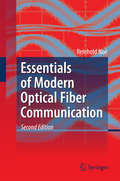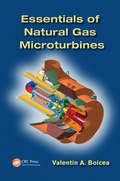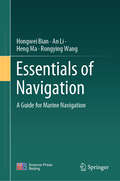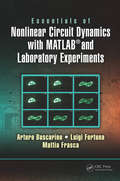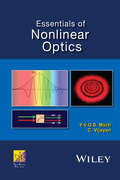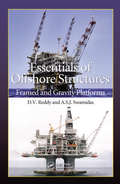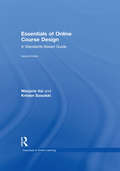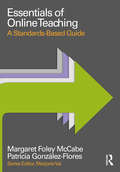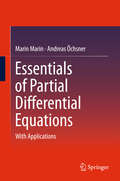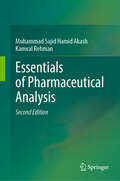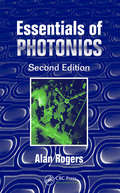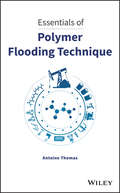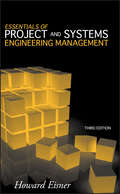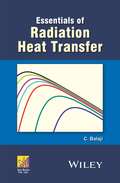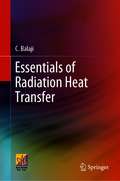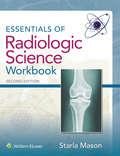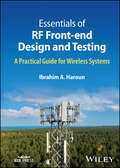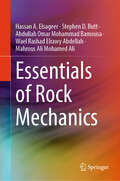- Table View
- List View
Essentials of Medicinal and Aromatic Crops
by Muhammad Zia-Ul-Haq Arwa Abdulkreem AL-Huqail Muhammad Riaz Umar Farooq GoharMedicinal and aromatic crops (MACs) are high-value crops since the natural products obtained from them are low-volume high-value commodities that have numerous applications in various sectors such as the food, beverage, food supplement, flavor and fragrance, perfumery and cosmetics, pharmaceutical and aromatherapy industries. In addition, the plant biomass is used in the production of teas and medical applications in traditional and also modern medicines. MACs are important mainly because they contain plant secondary metabolites such as essential oils, alkaloids, glygosides, saponins, tannins, vitamins and other bioactives. Plant secondary metabolites are differentiated from plant primary metabolites of photosynthesis and respiration since they are directly involved in growth and development of plants. Some MACs are used as spices and culinary herbs since they contain mainly essential oils, and are used as tonic to the digestive system, appetite modification and other systems and may facilitate nutrient uptake and utilization from various foods. A significant amount of MACs and their natural products have also demonstrated antimicrobial, antifungal and bactericidal activity and significant antioxidant capacity. In the past, MACs and their natural products have been used as a source for various medicines, in food and beverage production and in aroma products. Essentials of Medicinal and Aromatic Crops summarizes the current knowledge on medicinal and aromatic crops, including the agronomical practices of important MACs and their products, their beneficial effects and utilization of MAP and their products. The chapters provide a comprehensive guide to the most important and used medicinal and aromatic crops and their use in functional foods, nutraceuticals and as bioactives against various ailments, providing researchers, teachers, chemists, food scientists, agronomists and agroecologists in academia, industry and government a fully up to date singular source on this important topic.
Essentials Of Micro- and Nanofluidics: With Applications to the Biological and Chemical Sciences
by A. Terrence ConliskThis textbook introduces students to the basic physical principles to analyse fluid flow in micro- and nano-size devices. This is the first book that unifies the thermal sciences with electrostatics and electrokinetics and colloid science; electrochemistry; and molecular biology. Key concepts and principles are discussed, such as the essentials of viscous flows, introductory electrochemistry, heat and mass transfer phenomena, elements of molecular and cell biology and much more. State-of-the-art analytical and computational approaches to problems in all of these areas are presented, especially electrokinetic flows, and examples are given of the use of these approaches to design devices used for rapid molecular analysis, biochemical sensing, drug delivery, DNA analysis, the design of an artificial kidney and other transport phenomena. There are exercise problems and modern examples of applications, as well as a solutions manual available for qualified instructors.
Essentials of Mobile Handset Design
by Peter Whale Abhi NahaDiscover what is involved in designing the world's most popular and advanced consumer product to date - the phone in your pocket. With this essential guide you will learn how the dynamics of the market, and the pace of technology innovation, constantly create new opportunities which design teams utilize to develop new products that delight and surprise us. Explore core technology building blocks, such as chipsets and software components, and see how these components are built together through the design lifecycle to create unique handset designs. Learn key design principles to reduce design time and cost, and best practice guidelines to maximize opportunities to create a successful product. A range of real-world case studies are included to illustrate key insights. Finally, emerging trends in the handset industry are identified, and the global impact those trends could have on future devices is discussed.
Essentials of Modern Communications
by Djafar K. Mynbaev Lowell L. ScheinerExplore Modern Communications and Understand Principles of Operations, Appropriate Technologies, and Elements of Design of Communication Systems Modern society requires a different set of communication systems than has any previous generation. To maintain and improve the contemporary communication systems that meet ever-changing requirements, engineers need to know how to recognize and solve cardinal problems. In Essentials of Modern Communications, readers will learn how modern communication has expanded and will discover where it is likely to go in the future. By discussing the fundamental principles, methods, and techniques used in various communication systems, this book helps engineers assess, troubleshoot, and fix problems that are likely to occur. In this reference, readers will learn about topics like: How communication systems respond in time and frequency domains Principles of analog and digital modulations Application of spectral analysis to modern communication systems based on the Fourier series and Fourier transform Specific examples and problems, with discussions around their optimal solutions, limitations, and applications Approaches to solving the concrete engineering problems of modern communications based on critical, logical, creative, and out-of-box thinking For readers looking for a resource on the fundamentals of modern communications and the possible issues they face, Essentials of Modern Communications is instrumental in educating on real-life problems that engineering students and professionals are likely to encounter.
Essentials of Modern Optical Fiber Communication
by Reinhold NoéThis is a concise introduction into optical fiber communication. It covers important aspects from the physics of optical wave propagation and amplification to the essentials of modulation formats and receivers. The combination of a solid coverage of necessary fundamental theory with an in-depth discussion of recent relevant research results enables the reader to design modern optical fiber communication systems. The book serves both graduate students and professionals. It includes many worked examples with solutions for lecturers. For the second edition, Reinhold Noé made many changes and additions throughout the text so that this concise book presents the essentials of optical fiber communication in an easy readable and understandable way.
Essentials of Natural Gas Microturbines
by Valentin A. BoiceaAddressing a field which, until now, has not been sufficiently investigated, Essentials of Natural Gas Microturbines thoroughly examines several natural gas microturbine technologies suitable not only for distributed generation but also for the automotive industry. An invaluable resource for power systems, electrical, and computer science engineers
Essentials of Navigation: A Guide for Marine Navigation
by An Li Hongwei Bian Heng Ma Rongying WangThis book gives a basic introduction to navigation, from key concepts, basic principles, main technologies, equipment systems to the knowledge frame of navigation. The ten chapters fall into three parts: Chapters I~III introduce the elementary knowledge of navigation; Chapters IV~IX are devoted to the basic principles, and the optimization principle of integrated navigation as well; and Chapter X discusses the application of marine navigation, indicating the basic outline of the marine navigation system. The book clearly reflects the systematic idea of navigation knowledge from multiple perspectives, which is helpful for readers to build a holistic understanding of navigation from the concept, principle, characteristics, technology to the equipment system. At the end of each chapter, reflections beyond the fundamental knowledge of navigation are included to help readers further develop their scientific thinking and general literacy. This book is written primarily for students majoring in navigation, and it may also be of interest to researchers and practitioners engaged in navigation.
Essentials of Nonlinear Circuit Dynamics with MATLAB® and Laboratory Experiments
by Luigi Fortuna Arturo Buscarino Mattia FrascaThis book deals with nonlinear dynamics of electronic circuits, which could be used in robot control, secure communications, sensors and synchronized networks. The genesis of the content is related to a course on complex adaptive systems that has been held at the University of Catania since 2005. The efforts are devoted in order to emulate with nonlinear electronic circuits nonlinear dynamics. Step-by-step methods show the essential concepts of complex systems by using the Varela diagrams and accompanying MATLAB® exercises to reinforce new information. Special attention has been devoted to chaotic systems and networks of chaotic circuits by exploring the fundamentals, such as synchronization and control. The aim of the book is to give to readers a comprehensive view of the main concepts of nonlinear dynamics to help them better understand complex systems and their control through the use of electronics devices.
Essentials of Nonlinear Optics (Ane/Athena Books)
by C. Vijayan Y. V. MurtiCurrent literature on Nonlinear Optics varies widely in terms of content, style, and coverage of specific topics, relative emphasis of areas and the depth of treatment. While most of these books are excellent resources for the researchers, there is a strong need for books appropriate for presenting the subject at the undergraduate or postgraduate levels in Universities. The need for such a book to serve as a textbook at the level of the bachelors and masters courses was felt by the authors while teaching courses on nonlinear optics to students of both science and engineering during the past two decades. This book has emerged from an attempt to address the requirement of presenting the subject at college level. A one-semester course covering the essentials can effectively be designed based on this.
Essentials of Offshore Structures: Framed and Gravity Platforms
by D.V. Reddy A. S. SwamidasEssentials of Offshore Structures: Framed and Gravity Platforms examines the engineering ideas and offshore drilling platforms for exploration and production. This book offers a clear and acceptable demonstration of both the theory and application of the relevant procedures of structural, fluid, and geotechnical mechanics to offshore structures. It
Essentials of Online Course Design: A Standards-Based Guide (Essentials of Online Learning)
by Marjorie Vai Kristen SosulskiIn spite of the proliferation of online learning, creating online courses can still evoke a good deal of frustration, negativity, and wariness in those who need to create them. The second edition of Essentials of Online Course Design takes a fresh, thoughtfully designed, step-by-step approach to online course development. At its core is a set of standards that are based on best practices in the field of online learning and teaching. Pedagogical, organizational, and visual design principles are presented and modeled throughout the book, and users will quickly learn from the guide’s hands-on approach. The course design process begins with the elements of a classroom syllabus which, after a series of guided steps, easily evolve into an online course outline. The guide’s key features include: a practical approach informed by theory clean interior design that offers straightforward guidance from page one clear and jargon-free language examples, screenshots, and illustrations to clarify and support the text a checklist of online course design standards that readers can use to self-evaluate. a Companion Website with examples, adaptable templates, interactive learning features, and online resources: http://essentialsofonlinecoursedesign.com Essentials of Online Course Design serves as a best practice model for designing online courses. After reading this book, readers will find that preparing for online teaching is a satisfying and engaging experience. The core issue is simply good design: pedagogical, organizational, and visual. For more of Marjorie Vai in her own words, listen to this 2011 interview from the On Teaching Online podcast: http://onteachingonline.com/oto-16-essentials-of-online-course-design-with-marjorie-vai/
Essentials of Online Teaching: A Standards-Based Guide (Essentials of Online Learning)
by Margaret Foley McCabe Patricia González-FloresTeachers’ active online participation and engagement with students are critical factors to the success of online courses. Essentials of Online Teaching is a standards-based, straightforward guide to teaching online in higher education, high school and vocational training, or corporate learning environments. This brief but powerful book encourages immediate application of concepts with the help of real-world examples, technical insights, and professional advice. The guide includes: a practical approach informed by, but not about, relevant learning theories; clear models and examples from a wide variety of online courses; teachers’ reflections about their online practice; a checklist of standards to help guide teaching decisions; and an accompanying website (www.essentialsofonlineteaching.com) with additional resources. Essentials of Online Teaching addresses key instructional challenges in online teaching and presents the reader with practical solutions for each phase of a course—preparation, beginning, middle, and end.
Essentials of Partial Differential Equations: With Applications
by Andreas Öchsner Marin MarinThis book offers engineering students an introduction to the theory of partial differential equations and then guiding them through the modern problems in this subject. Divided into two parts, in the first part readers already well-acquainted with problems from the theory of differential and integral equations gain insights into the classical notions and problems, including differential operators, characteristic surfaces, Levi functions, Green’s function, and Green’s formulas. Readers are also instructed in the extended potential theory in its three forms: the volume potential, the surface single-layer potential and the surface double-layer potential. Furthermore, the book presents the main initial boundary value problems associated with elliptic, parabolic and hyperbolic equations. The second part of the book, which is addressed first and foremost to those who are already acquainted with the notions and the results from the first part, introduces readers to modern aspects of the theory of partial differential equations.
Essentials of Pharmaceutical Analysis
by Kanwal Rehman Muhammad Sajid AkashThis 2nd edition of the comprehensive resource on pharmaceutical analysis and analytical techniques builds upon the success of its first edition by incorporating updated methodologies, expanded content, and fresh insights into modern practices. Designed for students, researchers, and industry professionals alike, the book bridges theoretical principles with practical applications, covering both classical methods and innovative approaches across spectrophotometry, chromatography, mass spectrometry, and thermal analysis. Detailed chapters elucidate method development, instrumentation, quality control, and regulatory compliance, while enriched case studies and examples from environmental science, biomedical research, and materials science illustrate real-world applications. New sections highlight the integration of miniaturized instruments, hyphenated techniques, and computational tools including machine learning and cloud-based analytics. Enhanced diagrams, tables, and summaries further facilitate the understanding of complex analytical concepts. This edition not only reinforces essential foundational knowledge but also equips readers with advanced practical skills to meet evolving challenges in pharmaceutical research and quality assurance. Whether you are seeking a solid academic grounding or aiming to adopt cutting-edge techniques, this book provides an indispensable guide to mastering contemporary pharmaceutical analysis and the future of analytical chemistry. With its rigorous and accessible approach, this book serves as an essential reference that inspires innovation in analytical sciences.
Essentials of Photonics (Second Edition)
by Alan Rogers<p>The importance of photonics in science and engineering is widely recognized and will continue to increase through the foreseeable future. In particular, applications in telecommunications, medicine, astronomy, industrial sensing, optical computing and signal processing continue to become more diverse. <p>Essentials of Photonics, Second Edition describes the entire range of photonic principles and techniques in detail. Previously named Essentials of Optoelectronics, this newly named second edition of a bestseller felects changes that have occurred in this field. The book presents a new approach that concentrates on the physical principbestles, demonstrating their interdependence, and developing them to explain more complex phenomena. It gives insight into the underlying physical processes in a way that is readable and easy to follow, as well as entirely self-contained. <p>Written by an author with many years of experience in teaching and research, this book includes a detailed treatment of lasers, waveguides (including optical fibres), modulators, detectors, non-linear optics and optical signal processing. This new edition is brought up-to-date with additional sections on photonic crystal fibres, distributed optical-fibre sensing, and the latest developments in optical-fibre communications.</p>
Essentials of Polymer Flooding Technique
by Antoine ThomasProvides an easy-to-read introduction to the area of polymer flooding to improve oil production The production and utilization of oil has transformed our world. However, dwindling reserves are forcing industry to manage resources more efficiently, while searching for alternative fuel sources that are sustainable and environmentally friendly. Polymer flooding is an enhanced oil recovery technique that improves sweep, reduces water production, and improves recovery in geological reservoirs. This book summarizes the key factors associated with polymers and polymer flooding—from the selection of the type of polymer through characterization techniques, to field design and implementation—and discusses the main issues to consider when deploying this technology to improve oil recovery from mature reservoirs. Essentials of Polymer Flooding Technique introduces the area of polymer flooding at a basic level for those new to petroleum production. It describes how polymers are used to improve efficiency of “chemical” floods (involving surfactants and alkaline solutions). The book also offers a concise view of several key polymer-flooding topics that can’t be found elsewhere. These are in the areas of pilot project design, field project engineering (water quality, oxygen removal, polymer dissolution equipment, filtration, pumps and other equipment), produced water treatment, economics, and some of the important field case histories that appear in the last section. Provides an easy to read introduction to polymer flooding to improve oil production whilst presenting the underlying mechanisms Employs “In A Nutshell” key point summaries at the end of each chapter Includes important field case studies to aid researchers in addressing time- and financial-consumption in dealing with this issue Discusses field engineering strategies appropriate for professionals working in field operation projects Essentials of Polymer Flooding Technique is an enlightening book that will be of great interest to petroleum engineers, reservoir engineers, geoscientists, managers in petroleum industry, students in the petroleum industry, and researchers in chemical enhanced oil recovery methods.
Essentials of Positioning and Location Technology
by David BartlettMystified by locating and positioning technologies? Need to get the best from your location system? This guide is invaluable for understanding how the positions and movements of objects can be measured and used for real-world applications. From it, you'll learn how to optimise and manage system performance by working with parameters such as velocity, orientation, time, proximity and direction, and consider not only accuracy, but also reliability, integrity, response time and uncertainty. Packed with practical examples, this concise book gives you an overview of terrestrial radiolocation techniques, including comparative system architectures and real-world performance and limitations. It describes inertial navigation principles and techniques, including low-cost MEMS sensors for consumer products, and a range of applications, such as those benefiting from hybrid positioning techniques.
The Essentials of Power System Dynamics and Control
by Hemanshu Roy PotaThis book presents a general framework for modelling power system devices to develop complete electromechanical models for synchronous machines, induction machines, and power electronic devices. It also presents linear system analysis tools that are specific to power systems and which are not generally taught in undergraduate linear system courses. Lastly, the book covers the application of the models, analysis and tools to the design of automatic voltage controllers and power system stabilisers, both for single-machine-infinite-bus systems and multi-machine interconnected systems.In most textbooks modelling, dynamic analysis, and control are closely linked to the computation methods used for analysis and design. In contrast, this book separates the essential principles and the computational methods used for power system dynamics and control. The clear distinction between principles and methods makes the potentially daunting task of designing controllers for power systems much easier to approach.A rich set of exercises is also included, and represents an integral part of the book. Students can immediately apply—using any computational tool or software—the essential principles discussed here to practical problems, helping them master the essentials.
Essentials of Project and Systems Engineering Management
by Howard EisnerThe Third Edition of Essentials of Project and Systems Engineering Management enables readers to manage the design, development, and engineering of systems effectively and efficiently. The book both defines and describes the essentials of project and systems engineering management and, moreover, shows the critical relationship and interconnection between project management and systems engineering. The author's comprehensive presentation has proven successful in enabling both engineers and project managers to understand their roles, collaborate, and quickly grasp and apply all the basic principles.Readers familiar with the previous two critically acclaimed editions will find much new material in this latest edition, including:Multiple views of and approaches to architecturesThe systems engineer and software engineeringThe acquisition of systemsProblems with systems, software, and requirementsGroup processes and decision makingSystem complexity and integrationThroughout the presentation, clear examples help readers understand how concepts have been put into practice in real-world situations.With its unique integration of project management and systems engineering, this book helps both engineers and project managers across a broad range of industries successfully develop and manage a project team that, in turn, builds successful systems. For engineering and management students in such disciplines as technology management, systems engineering, and industrial engineering, the book provides excellent preparation for moving from the classroom to industry.
Essentials of Radiation Heat Transfer (Ane/Athena Books)
by C. BalajiEssentials of Radiation Heat Transfer presents the essential, fundamental information required to gain an understanding of radiation heat transfer and equips the reader with enough knowledge to be able to tackle more challenging problems. All concepts are reinforced by carefully chosen and fully worked examples, and exercise problems are provided at the end of every chapter.
Essentials of Radiation Heat Transfer (Ane/athena Bks.)
by C. BalajiEssentials of Radiation Heat Transfer focuses only on the essential topics required to gain an understanding of radiation heat transfer to enable the reader to master more challenging problems. The strength of the book lies in its elaborate presentation of the powerful radiosity-irradiation method and shows how this technique can be used to solve a variety of problems of radiation in enclosures made of one to any number of surfaces in both transparent and participating media. The book also introduces atmospheric radiation in which engineers can contribute to the technology of remote sensing and atmospheric sciences in general, by a better understanding of radiation.The author has included pedagogical features such as end-of-chapter exercises and worked examples with varying degrees of difficulty to augment learning and self-testing. The book has been written in an easy- to- follow conversational style to enhance reader engagement and learning outcomes. This book will be a useful guide for upper undergraduate and graduate students in the areas of mechanical engineering, aerospace engineering, atmospheric sciences, and energy sciences.
Essentials of Radiologic Science Workbook
by Starla MasonEssentials of Radiologic Science Workbook, Second Edition, is designed to accompany Essentials of Radiologic Science, Second Edition and provides students with additional practice applying difficult theories. This Workbook also serves as preparation for The American Registry of Radiologic Technologists Examination in Radiography and includes Registry-style review questions, as well as other exercises to appeal to different learning styles. Features of the Workbook: Registry-style multiple choice review questions assess knowledge and provide preparation for the registry examination Image labeling exercises enhance learning with visual reinforcement of material Crossword puzzles offer an enjoyable way for students to review relevant terms and concepts Laboratory Experiments provide students with opportunities to directly apply their learning with hands-on activities
Essentials of RF Front-end Design and Testing: A Practical Guide for Wireless Systems
by Ibrahim A. HarounEssentials of RF Front-end Design and Testing Highly comprehensive text delivering the RF system essentials required to understand, develop, and evaluate the performance of RF wireless systems Essentials of RF Front-end Design and Testing: A Practical Guide for Wireless Systems is a system-oriented book which provides several wireless communication disciplines in one volume. The book covers a wide range of topics, including antenna fundamentals, phased array antenna and MIMOs that are crucial for the latest 5G mmWave and future 6G wireless systems, high-frequency transmission lines, RF building blocks that are necessary to understand how various RF subsystems are interrelated and implemented in wireless systems, and test setups for conducted and Over-The-Air (OTA) transmitter and receiver tests. The text enables readers to understand, develop, and evaluate the performance of RF wireless systems. The text focuses on RF system performance and testing rather than mathematical proofs, which are available in the provided references. Although the book is intended for testing and building RF system prototypes, it has the sufficient theoretical background needed for RF systems design and testing. Each chapter includes learning objectives, review questions, and references. Sample topics covered in the book include: An overview of cellular phone systems, 5G NR wireless technology, MIMO technology, terahertz communications for 6G wireless technology, and modulation and multiplexing Analog and digital modulation techniques, including AM, SSB, FM, FSK, PSK, QAM, SSFH, DSSS, and OFDM High-frequency transmission lines, S-parameters, low-noise amplifier, RF mixers, filters, power amplifiers, frequency synthesizers, circulators/isolators, directional couplers, RF switches, and RF phase shifters Antenna basics, including antenna gain, radiation pattern, input impedance, polarization, and antenna noise temperature; microstrip antenna, antenna array, propagation path loss, compact antenna test range (CATR), and test setups for antenna measurements. Basics of MIMO and beamforming technology, including analog, digital, and hybrid beamforming Test setups for characterizing the key RF performance parameters of 5G New Radio base station transmitters and receivers. Essentials of RF Front-end Design and Testing: A Practical Guide for Wireless Systems is a highly comprehensive resource on the subject and is intended for graduate engineers and technologists involved in designing, developing, and testing wireless systems, along with undergraduate/graduate students, enhancing their learning experience of RF subsystems/systems characterization.
Essentials of Risk Theory
by Per Sandin Rafaela Hillerbrand Sabine Roeser Martin PetersonRisk has become one of the main topics in fields as diverse as engineering, medicine and economics, and it is also studied by social scientists, psychologists and legal scholars. This Springer Essentials version offers an overview of the in-depth handbook and highlights some of the main points covered in the Handbook of Risk Theory. The topic of risk also leads to more fundamental questions such as: What is risk? What can decision theory contribute to the analysis of risk? What does the human perception of risk mean for society? How should we judge whether a risk is morally acceptable or not? Over the last couple of decades questions like these have attracted interest from philosophers and other scholars into risk theory. This brief offers the essentials of the handbook provides for an overview into key topics in a major new field of research and addresses a wide range of topics, ranging from decision theory, risk perception to ethics and social implications of risk. It aims to promote communication and information among all those who are interested in theoretical issues concerning risk and uncertainty. The Essentials of Risk Theory brings together internationally leading philosophers and scholars from other disciplines who work on risk theory. The contributions are accessibly written and highly relevant to issues that are studied by risk scholars. The Essentials of Risk Theory will be a helpful starting point for all risk scholars who are interested in broadening and deepening their current perspectives.
Essentials of Rock Mechanics
by Hassan A. Elsageer Stephen D. Butt Abdullah Omar Mohammad Bamousa Wael Rashad Abdellah Mahrous Ali AliThis book extensively covers rock mechanics and engineering, playing a vital role in mining, geological, and civil applications. It explores the stability, failure, and behavior of rock masses, offering control and prediction methods. Fundamental concepts, stress and strain analyses, failure theories, and rock characteristics are addressed, essential for safety in mining and construction. Applications like geological hazard assessment, slope stability, and foundation design demonstrate its significance in civil and geological engineering. The book's structured approach includes an overview in Chapter 1, stress analyses in Chapter 2, and plane strain analyses in Chapter 3. Subsequent chapters delve into rock behavior, failure theories, and specific properties. Practical aspects, such as designing underground openings, are covered in later chapters. The incorporation of numerous solved tutorials enhances its value for students and educators seeking a comprehensive understanding of these pivotal topics.
